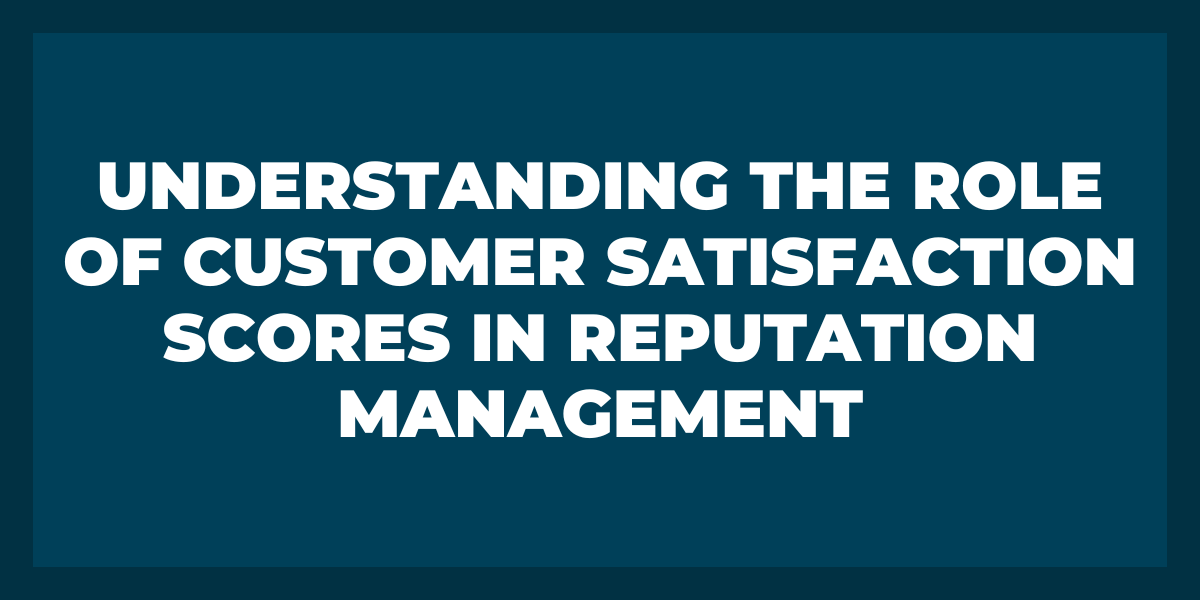Reputation is everything for the business’s success and sustainability, as it directly impacts consumer trust, loyalty, and purchasing decisions. Customer satisfaction, in turn, demonstrates the client experience quality and can make or break a brand’s reputation.
Reputation management involves active monitoring, influencing, and shaping the public perception of a business or brand. To improve customer satisfaction and enhance the overall client experience, businesses should prioritize proactive communication and personalized support.
What Is Customer Satisfaction Score?

Source
Customer satisfaction score (CSAT) is a metric used to measure customer contentment or happiness with a particular product, service, or overall experience. It’s a numerical rating or a percentage, reflecting the extent to which clients are pleased with their interactions and feel that their expectations are met. American Customer Satisfaction Index is a widely recognized metric used in various industries.
Marketers use CSAT surveys, feedback forms, or other means of collecting client input to get valuable metrics. Thus, businesses can measure customer satisfaction levels and identify areas for improvement.
The most common methods of measuring CSAT include:
- CSAT survey and feedback forms: One effective method is through the use of customer satisfaction metrics. These metrics can be obtained by collecting feedback from clients, either through numerical ratings or qualitative feedback;
- Net Promoter Score (NPS): Calculating eNPS can provide valuable insights into the overall satisfaction and loyalty of employees within an organization. It gauges the likelihood of clients recommending a business to others based on a scale of 0 to 10. Based on responses to open-ended questions, consumers are categorized as promoters (9-10), passives (7-8), or detractors (0-6). The NPS score is calculated by subtracting the percentage of detractors from the percentage of promoters;
- Online reviews and ratings: Customer sentiment can be effectively gauged through review websites or social media platforms, where clients have the opportunity to share their experiences.
Different businesses choose the measurement method that best suits their needs and resources.
The Importance of Customer Satisfaction Score in Reputation Management
Customer happiness directly impacts a business’s reputation, and CSAT serves as a valuable metric needed to measure consumer perception. Positive CSAT scores contribute to a strong reputation, enhancing the credibility and trustworthiness of a business in the eyes of consumers and the general public. On the other hand, low CSAT scores can negatively impact a business’s image and lead to high customer churn.
Consistent CSAT tracking allows businesses to track changes in customer perception over time and take proactive steps to address any arising issues. Moreover, CSAT is closely linked to customer loyalty and advocacy. Satisfied customers are more likely to become loyal clients and advocates for the business.
To enhance customer engagement and loyalty, businesses can adopt an omnichannel strategy. By integrating various communication channels such as social media, email, live chat, and phone support, companies can provide a seamless and consistent experience across multiple touchpoints.
CSAT Benefits for Reputation Management
At this point, it’s clear that CSAT is a crucial factor for building, maintaining, and managing a business or brand reputation. To better understand the CSAT’s impact on reputation management, let’s take a closer look at the benefits it offers.
Identifying Areas for Improvement
CSAT surveys help businesses understand their strengths and weaknesses from a customer’s perspective. By collecting feedback on various aspects of the product or service, such as quality, support, and overall experience, companies can identify areas where they excel and those that require improvement. Moreover, by using Customer Success Software they can streamline this process further and centralize all the feedback in one place.
Identifying Dissatisfied Customers
Customer satisfaction surveys also help in identifying dissatisfied customers before they become vocal critics. Customer effort score is a metric that assesses the ease of doing business with a company from the customer’s perspective. By promptly addressing negative feedback and efficiently resolving client issues, either through email or by phone, companies can minimize customer effort and prevent negative publicity.
Another technique that can contribute to proactive customer support and effective complaint resolution is review scraping. By monitoring and analyzing customer reviews across various platforms, companies can gain valuable insights into customer satisfaction levels and identify potential issues early on. Review scraping allows businesses to gather feedback at scale, enabling them to address dissatisfied customers promptly and implement necessary improvements.
Enhancing Customer Experiences
Monitoring CSAT helps businesses identify and understand customer expectations and preferences. Thus, companies will be able to tailor their products, services, and interactions to meet consumer needs more effectively. By addressing consumer concerns and consistently improving contentment levels, they can enhance customer experiences, exceed expectations, and build a positive brand image. Positive buying experiences, in turn, contribute to a strong reputation and further foster client loyalty.
Increasing Customer Retention
Satisfied customers are more likely to remain loyal and continue doing business with a company. By addressing their needs, concerns and providing customer support with an empathetic and assertive communication style, companies can build strong relationships with buyers and improve CSAT to increase client retention rates.
Loyal customers contribute not only to revenue growth but also to positive company perception, serving as brand ambassadors and attracting new clients through positive recommendations. By incorporating effective social media marketing strategies, businesses can leverage the power of social platforms to engage with their target audience and drive customer loyalty.
Benchmarking and Competitor Analysis
A company can use CSAT scores as benchmarks to assess its performance against competitors and industry standards to gain insights into its market position and identify areas for improvement. Consistently monitoring CSAT scores allows companies to maintain a competitive edge and strengthen their reputation in the industry.
Data-Driven Decision Making
Marketers can analyze quantitative and qualitative data from CSAT surveys to make informed decisions. By examining the feedback and consumer satisfaction data, businesses can identify and access management trends, patterns, and areas of concern.
Using Customer Satisfaction Score in Reputation Management
Over 93% of customers admit that online reviews and comments influence their purchasing decisions. 25% of the business market share relates to its reputation, and each 1% of the annual increase in customer contentment boosts profit by more than 11%.
All of the above components are interconnected and demonstrate the necessity to integrate good scores of customer satisfaction into reputation management approaches to achieve higher efficiency and level up buying experience to the max.
Here are the strategies for implementing CSAT in reputation management:
- Collecting and analyzing customer satisfaction data: Develop and implement customer satisfaction surveys or feedback mechanisms to collect data on customer engagement and distribute them via email, websites, or mobile apps. It’s essential to follow tokenization best practices to safeguard sensitive customer data, mitigating the risk of data breaches.
- Responding to customer feedback and resolving issues: Throughout the customer lifecycle, it is essential to prioritize timely responses to customer reviews. By promptly addressing great customer feedback, businesses can demonstrate their attentiveness, care, and commitment to resolving any concerns.
- Seeking customer satisfaction and feedback: After customer interactions or purchases, send follow-up customer satisfaction surveys or touchpoints to gather feedback on specific experiences. Encourage consumers to share their experiences, suggestions, or concerns via email, live chat, or dedicated interactive forms;
- Incorporating CSAT into decision-making processes: Establish measurable CSAT goals and standards to track progress and performance and use good scores as a key performance indicator (KPI) for reputation management efforts.
Limitations of CSAT in Reputation Management
Offering a lot of benefits to reputation management, the customer satisfaction score has a few limitations and challenges that should be considered to create an efficient reputation management strategy.
- Bias: Client feedback and CSAT data could be subjective and influenced by individual perceptions and biases. Different customers may interpret contentment levels differently, leading to variability in responses;
- Limited representation of opinions: Only a subset of purchasers may choose to respond to surveys or provide feedback, potentially resulting in a lack of diversity and limited representation of overall customer satisfaction;
- Difficulty in measuring intangible aspects: Such aspects as emotional connection, brand perception, or trust are challenging to measure using traditional CSAT metrics.
Companies should acknowledge these challenges and consider using additional methods and metrics, such as sentiment analysis, online reviews, or social media monitoring, to gain a more comprehensive understanding of customer engagement and reputation.
Frequently Asked Questions
How is the customer satisfaction score measured?
CSAT can be measured through various methods, including post-purchase surveys, feedback forms, online reviews, or ratings. The scores are then aggregated and analyzed to determine the overall CSAT and customer success.
Are there any industry benchmarks for customer satisfaction scores?
There are no universally applicable CSAT benchmarks. Marketers can look for industry-specific standards or conduct benchmarking studies to compare their CSAT scores with competitors or industry averages.
How can businesses respond to low CSAT scores?
Businesses should take low CSAT scores as an opportunity for improvement. They should carefully analyze the feedback received, identify the root causes of dissatisfaction, and take prompt action to address the issues. This may involve revising processes, training employees, enhancing product or service offerings, or improving communication with customers to regain trust.
Summing Up
Customer satisfaction surveys play a significant role in reputation management by measuring consumer contentment levels and guiding improvements in the customer journey. By prioritizing CSAT in reputation management, businesses can strengthen their position in the market and create long-term success.




















